 W
WAptenoperissus is a genus of extinct wasp with eight described species, placed into the monotypic family Aptenoperissidae. The type species Aptenoperissus burmanicus resembles a mix between a grasshopper, an ant, and a wasp. It was described by a group of researchers from Oregon State University in a paper released online in October 2016. The piece of 100 million year old Burmese amber that it was preserved in was found in the Hukawng Valley of Myanmar in Southern Asia. A new family, Aptenoperissidae, was described to accommodate this insect. Aptenoperissus had a strong stinger for defense against predators and to stab grubs for its food. The creature had long legs making it perfect for jumping higher than most insects. Subsequently additional species were described from the Myanmar amber: A. amabilis, A. delicatus, A. formosus, A. etius, A. magnifemoris, A. pusillus and A. zonalis.
 W
WPlumalexius is a genus of wasps in the extinct monotypic family Plumalexiidae, containing two species: the type species Plumalexius rasnitsyni, known from the Late Cretaceous White Oaks Pit in Sayreville, New Jersey, and Plumalexius ohmkuhnlei, known from the Cretaceous Burmese amber.
 W
WThe family Agaonidae is a group of pollinating and nonpollinating fig wasps. They spend their larval stage inside the fruits of figs. The pollinating wasps are the mutualistic partners of the fig trees. The nonpollinating fig wasps are parasitic. Extinct forms from the Eocene and Miocene are nearly identical to modern forms, suggesting that the niche has been stable over geologic time.
 W
WThe Ampulicidae, or cockroach wasps, are a small, primarily tropical family of sphecoid wasps, all of which use various cockroaches as prey for their larvae. They tend to have elongated jaws, pronounced neck-like constrictions behind the head, strongly petiolate abdomens, and deep grooves on the thorax. Many are quite ant-like in appearance, though some are brilliant metallic blue or green.
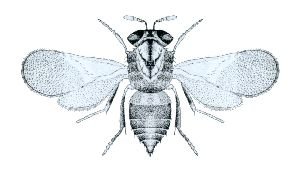 W
WThe Aphelinidae are a moderate-sized family of tiny parasitic wasps, with about 1100 described species in some 28 genera. These minute insects are challenging to study, as they deteriorate rapidly after death unless extreme care is taken, making identification of most museum specimens difficult. The larvae of the majority are primary parasitoids on Hemiptera, though other hosts are attacked, and details of the life history can be variable. Males and females may have different hosts and different life histories.
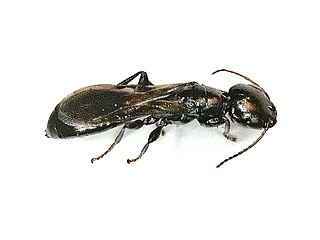 W
WThe Bethylidae are a family of aculeate wasps in the superfamily Chrysidoidea. As a family, their biology ranges between parasitoid wasps and hunting wasps.
 W
WThe Braconidae are a family of parasitoid wasps. After the closely related Ichneumonidae, braconids make up the second-largest family in the order Hymenoptera, with about 17,000 recognized species and many thousands more undescribed. One analysis estimated a total between 30,000 and 50,000, and another provided a narrower estimate between 42,000 and 43,000 species.
 W
WThe Bradynobaenidae are a family of wasps similar to the Mutillidae, differing most visibly in the presence, in females, of a suture separating the pronotum from the mesonotum. These species are often found in arid regions. Recent classifications remove two of the five constituent genera, both from the New World, to a separate family Chyphotidae, thus restricting true bradynobaenids to the Old World.
 W
WThe Ceraphronidae are a small hymenopteran family with 14 genera and some 360 known species, though a great many species are still undescribed. It is a poorly known group as a whole, though most are believed to be parasitoids, and a few hyperparasitoids. Many are found in the soil, and of these, a number are wingless.
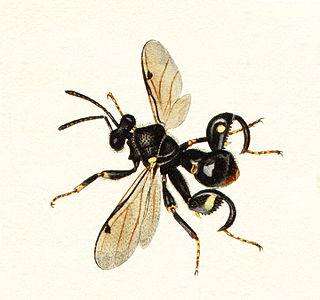 W
WThe Chalcididae are a moderate-sized family within the Chalcidoidea, composed mostly of parasitoids and a few hyperparasitoids. The family is apparently polyphyletic, though the different subfamilies may each be monophyletic, and some may be elevated to family status in the near future. As presently defined, there are over 85 genera and over 1460 species worldwide. They are often black with yellow, red, or white markings, rarely brilliantly metallic, with a robust mesosoma and very strong sculpturing. The hind femora are often greatly enlarged, with a row of teeth or serrations along the lower margin.
 W
WCommonly known as cuckoo wasps or emerald wasps, the hymenopteran family Chrysididae is a very large cosmopolitan group of parasitoid or kleptoparasitic wasps, often highly sculptured, with brilliant metallic colors created by structural coloration. They are most diverse in desert regions of the world, as they are typically associated with solitary bee and wasp species, which are also most diverse in such areas. Their brood parasitic lifestyle has led to the evolution of fascinating adaptations, including chemical mimicry of host odours by some species.
 W
WThe Chyphotidae are a family of wasps similar to the Mutillidae, differing most visibly in the presence, in females, of a suture separating the pronotum from the mesonotum. These species are found primarily in arid regions in the southwestern United States and adjacent regions in Mexico.
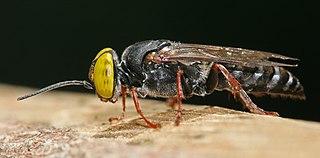 W
WThe Crabronidae are a large paraphyletic group of wasps, including nearly all of the species formerly comprising the now-defunct superfamily Sphecoidea. It collectively includes well over 200 genera, containing well over 9000 species. Crabronids were originally a part of Sphecidae, but the latter name is now restricted to a separate family based on what was once the subfamily Sphecinae. Several of the subfamilies of Crabronidae are often treated as families in their own right, as is true of the most recent phylogenies.
 W
WGall wasps, also incorrectly called gallflies, are hymenopterans of the family Cynipidae in the wasp superfamily Cynipoidea. Their common name comes from the galls they induce on plants for larval development. About 1,300 species of this generally very small creature (1–8 mm) are known worldwide, with about 360 species of 36 different genera in Europe and some 800 species in North America.
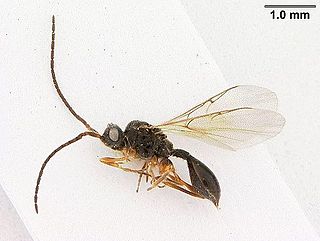 W
WThe Diapriidae are a family of parasitoid wasps. These tiny insects have an average length of 2–4 mm and never exceed 8 mm. They typically attack larvae and pupae of a wide range of insects, especially flies. The about 2,300 described species in 150 genera are divided into three subfamilies, and the group has a global distribution.
 W
WDryinidae is a cosmopolitan family of solitary wasps. Its name comes from the Greek drys for oak: Latreille named the type genus Dryinus because the first species was collected in an oak plant in Spain. The larvae are parasitoids of the nymphs and adults of Auchenorrhyncha. Dryinidae comprises approximately 1900 described species, distributed in 17 subfamilies and 53 genera.
 W
WEmbolemidae is a small family of around 64 species and 3 genera distributed around the world. They are small solitary parasitoid wasps, and are parasites on planthopper nymphs of the families Achilidae and Cixiidae.
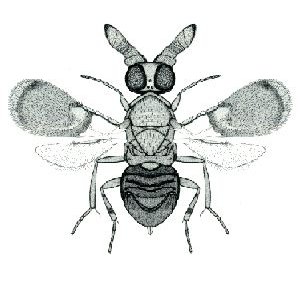 W
WEncyrtidae is a large family of parasitic wasps, with some 3710 described species in about 455 genera. The larvae of the majority are primary parasitoids on Hemiptera, though other hosts are attacked, and details of the life history can be variable. They are found throughout the world in virtually all habitats, and are extremely important as biological control agents. They may also present as an ecological threat to the population of some species. For example, the endangered Papilio homerus butterfly is parasitized at a rate of 77%. Parasitic wasps are the main contributor to egg mortality in the butterfly species.
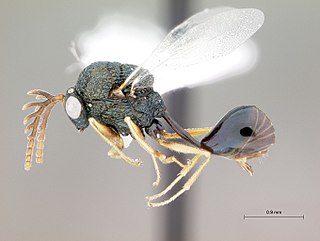 W
WThe Eucharitidae are a family of parasitic wasps. Eucharitid wasps are members of the superfamily Chalcidoidea and consist of three subfamilies: Oraseminae, Eucharitinae, and Gollumiellinae. Most of the 55 genera and 417 species of Eucharitidae are members of the subfamilies Oraseminae and Eucharitinae, and are found in tropical regions of the world.
 W
WThe Eulophidae are a large family of hymenopteran insects, with over 4,300 described species in some 300 genera. The family includes the genus Elasmus, which used to be treated as a separate family, "Elasmidae", and is now treated as a subfamily of Eulophidae. These minute insects are challenging to study, as they deteriorate rapidly after death unless extreme care is taken, making identification of most museum specimens difficult. The larvae of a very few species feed on plants, but the majority are primary parasitoids on a huge range of arthropods at all stages of development. They are exceptional in that they are one of two hymenopteran families with some species that are known to parasitize Thysanoptera. Eulophids are found throughout the world in virtually all habitats.
 W
WEupelmidae is a family of parasitic wasps in the superfamily Chalcidoidea. The group is apparently polyphyletic, though the different subfamilies may each be monophyletic, and may be elevated to family status in the near future. As presently defined, there are over 905 described species in 45 genera. The larvae of the majority are primary parasitoids, commonly on beetle larvae, though many other hosts are attacked, including spiders, and details of the life history can be variable. They are found throughout the world in virtually all habitats.
 W
WThe Eurytomidae are a family within the superfamily Chalcidoidea. The group is apparently polyphyletic, though the different subfamilies may each be monophyletic, and may be elevated to family status in the near future. As of 2004, some 1420 species in 87 genera are described.
 W
WEvaniidae is a family of parasitoid wasps also known as ensign wasps, nightshade wasps, hatchet wasps, or cockroach egg parasitoid wasps. They number around 20 extant genera containing over 400 described species, and are found all over the world except in the polar regions. The larvae of these solitary wasps are parasitoids that feed on cockroaches and develop inside the egg-cases, or oothecae, of their hosts.
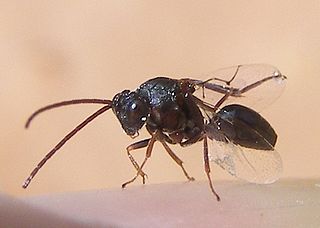 W
WFigitidae is a family of parasitoid wasps. The full diversity of this wasp family is not yet known, but about 1400 species have been described to over 130 genera. For example, the largest subfamily, Eucoilinae, has over 1000 described species so far, but this is probably just a fraction of the total diversity. Figitid species occur throughout most of the world.
 W
WAnts are eusocial insects of the family Formicidae and, along with the related wasps and bees, belong to the order Hymenoptera. Ants appear in the fossil record across the globe in considerable diversity during the latest Early Cretaceous and early Late Cretaceous, suggesting an earlier origin. Ants evolved from vespoid wasp ancestors in the Cretaceous period, and diversified after the rise of flowering plants. More than 13,800 of an estimated total of 22,000 species have been classified. They are easily identified by their geniculate (elbowed) antennae and the distinctive node-like structure that forms their slender waists.
 W
WGall wasps, also incorrectly called gallflies, are hymenopterans of the family Cynipidae in the wasp superfamily Cynipoidea. Their common name comes from the galls they induce on plants for larval development. About 1,300 species of this generally very small creature (1–8 mm) are known worldwide, with about 360 species of 36 different genera in Europe and some 800 species in North America.
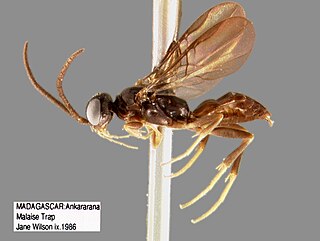 W
WHeterogynaidae is a minor and disputed lineage of small spheciform wasps occurring in Madagascar, Botswana, Turkmenistan, Oman, the United Arab Emirates, and the Eastern Mediterranean area. The majority are dark in color and range in size from approximately 1.5 to 5.0 mm. Most specimens have been collected in arid climates, but one species from Madagascar is known to occur in a humid forest habitat. Although males have functional wings, heterogynaid females are typically brachypterous, a trait which is unique among spheciform wasps. Wing venation is reduced in both sexes. All species are diurnal, with the exception of H. nocticola. Other aspects of their biology are completely unknown, but details of their morphology have prompted researchers to hypothesize that they may be non-fossorial parasitoids adapted to hunt in tight spaces, such as under tree bark. This is speculative and has not yet been confirmed by actual observations of behavior. It is also possible that modifications of the female metasomal tergum VI and gonostyli may represent a unique prey transport mechanism, but this is also unconfirmed.
 W
WThe Ibaliidae are a small family of hymenopteran superfamily Cynipoidea. Ibaliidae differ from most of the cynipoids by the larvae being parasitoids on other wasp larvae in the group Siricidae. The Ibaliidae comprise three extant genera of fairly large wasps, with a total of 20 species, and is a sister group to the rest of the cynipoids except the small subfamily Austrocynipidae.
 W
WThe Ichneumonidae, also known as the ichneumon wasps or ichneumonids, is a parasitoid wasp family within the insect order Hymenoptera. This insect family is among the most species-rich branches of the tree of life. At the same time, it is one of the groups for which our knowledge most severely lags behind their actual diversity. The roughly 25,000 species described today probably represent less than a quarter of their true richness, but reliable estimates are lacking, as is much of the most basic knowledge about their ecology, distribution and evolution. Ichneumonid wasps, with very few exceptions, attack the immature stages of holometabolous insects and spiders, eventually killing their hosts. They thus fulfill an important role as regulators of insect populations, both in natural and semi-natural systems, making them promising agents for biological control.
 W
WThe Leucospidae are a specialized group of wasps within the superfamily Chalcidoidea, that are ectoparasitoids of aculeate wasps or bees. They are typically mimics of bees or stinging wasps, often black with yellow, red, or white markings, sometimes metallic, with a robust mesosoma and very strong sculpturing. The hind femora are often greatly enlarged, with a row of teeth or serrations along the lower margin as in Chalcididae. The wing has a longitudinal fold. The female ovipositor is sometimes short, but if not, it is recurved and lies along the dorsal side of the metasoma, a unique feature. The males are also unusual, in the fusion of many of the metasomal segments to form a capsule-like "carapace".
 W
WMaaminga is a genus of parasitic wasps containing two species and constituting the family Maamingidae. So far only known from New Zealand, the two named species are Maaminga marrisi and M. rangi. The genus name derives from the Māori word "māminga", simply translated as "trickster" as the species evaded discovery for so long.
 W
WMegalyroidea is a small hymenopteran superfamily that includes a single family, Megalyridae, with eight extant genera and 49 described species. Modern megalyrids are found primarily in the southern hemisphere, though fossils have only been found in the northern hemisphere. The most abundant and species-rich megalyrid fauna is in Australia. Another peak of diversity appears to be in the relict forests of Madagascar, but most of these species are still undescribed.
 W
WMegastigmidae is a family of chalcid wasps in the order Hymenoptera. There are about 12 genera and more than 170 described species in Megastigmidae. Megastigmidae was formerly considered a subfamily of the family Torymidae.
 W
WThe Mutillidae are a family of more than 7,000 species of wasps whose wingless females resemble large, hairy ants. Their common name velvet ant refers to their dense pile of hair, which most often is bright scarlet or orange, but may also be black, white, silver, or gold. Their bright colors serve as aposematic signals. They are known for their extremely painful stings,, hence the common name cow killer or cow ant. However, mutillids are not aggressive and sting only in defense. In addition, the actual toxicity of their venom is much lower than that of honey bees or harvester ants. Unlike true ants, they are solitary, and lack complex social systems.
 W
WThe Mymaridae, commonly known as fairyflies or fairy wasps, are a family of chalcid wasps found in temperate and tropical regions throughout the world. The family contains around 100 genera with 1400 species.
 W
WThe Mymarommatidae, sometimes referred to as False fairy wasps. are a very small family of microscopic hymenopteran insects. Only about half of the known species are living taxa, but they are known from all parts of the world. Undoubtedly, many more await discovery, as they are easily overlooked and difficult to study due to their extremely small size.
 W
WThe Myrmosidae are a small family of wasps very similar to the Mutillidae. As in mutillids, females are flightless, and are kleptoparasites in the nests of fossorial bees and wasps.
 W
WThe Ormyridae are a small family of parasitic wasps in the superfamily Chalcidoidea. They are either parasitoids or hyperparasitoids on gall-forming insects, primarily cynipid wasps and tephritid flies. The 120 or so species in three genera are cosmopolitan, except almost entirely absent from South America.
 W
WThe genus Pelecinus is the only living member of the family Pelecinidae, and contains only three species, restricted to the New World. One species, Pelecinus polyturator, occurs from North through South America, and the others occur in Mexico and South America. The females are glossy wasps, very long and the abdomen is extremely attenuated, used to lay eggs directly on scarab larvae buried in the soil.
 W
WThe Perilampidae are a small family within the Chalcidoidea, composed mostly of hyperparasitoids. The family is closely related to the Eucharitidae, and the eucharitids appear to have evolved from within the Perilampidae, thus rendering the family paraphyletic. As presently defined, at least 15 genera and 270 species are described worldwide. They are often brilliantly metallic, with robust mesosomae and a small, triangular metasomae. They are generally very strongly sculptured. The prothorax is typically very broad and disc-like, and the labrum is multidigitate, a feature shared with the Eucharitidae.
 W
WThe hymenopteran family Platygastridae is a large group of exclusively parasitoid wasps, mostly very small (1–2 mm), black, and shining, with geniculate (elbowed) antennae that have an eight-segmented flagellum. The wings sometimes lack venation, though they may have slight fringes of setae.
 W
WWasps in the family Pompilidae are commonly called spider wasps, spider-hunting wasps, or pompilid wasps. The family is cosmopolitan, with some 5,000 species in six subfamilies. Nearly all species are solitary, and most capture and paralyze prey, though members of the subfamily Ceropalinae are kleptoparasites of other pompilids, or ectoparasitoids of living spiders.
 W
WProctotrupidae is a family of wasps in the superfamily Proctotrupoidea of the order Hymenoptera. There are about 400 species in more than 30 genera in Proctotrupidae, found throughout most of the world.
 W
WThe Pteromalidae are a very large family of mostly parasitoid wasps, with some 3,450 described species in about 640 genera. The subfamily-level divisions of the family are highly contentious and unstable, and the family thought to be "artificial", composed of numerous, distantly related groups (polyphyletic). Accordingly, details of their life histories range over nearly the entire range possible within the Chalcidoidea, though the majority are parasitoids of other insects. They are found throughout the world in virtually all habitats, and many are important as biological control agents. The oldest known fossil is known from the Early Cretaceous
 W
WRhopalosomatidae is a family of Hymenoptera containing about 68 extant species in four genera that are found worldwide. Three fossil genera are known.
 W
WThe Rotoitidae are a very small family of rare, relictual parasitic wasps in the superfamily Chalcidoidea, known primarily from fossils. Only two extant species are known, each in its own genus, one from New Zealand and one from Chile, and little is known about their biology. Females of the Chilean species, Chiloe micropteron, have their wings reduced to tiny bristles. Most fossil species are known from the Taimyr amber of Russia and Canadian amber, but one species, Baeomorpha liorum is known from the Burmese amber.
 W
WThe Sapygidae are a family of solitary kleptoparasitic aculeate wasps. They are generally black wasps, similar in appearance to some Tiphiidae or Thynnidae, with white or yellow markings developed to various degrees.
 W
WThe Sclerogibbidae are a small family of aculeate wasps in the superfamily Chrysidoidea.
 W
WThe Scoliidae, the scoliid wasps, are a family of about 560 species found worldwide. They tend to be black, often marked with yellow or orange, and their wing tips are distinctively corrugated. Males are more slender and elongated than females, with significantly longer antennae, but the sexual dimorphism is not as apparent as in the Tiphiidae.
 W
WThe Sierolomorphidae are a family of about 10 known species of wasps, all in the genus Sierolomorpha, found in the Northern Hemisphere. They are rare and very little is known of their biology.
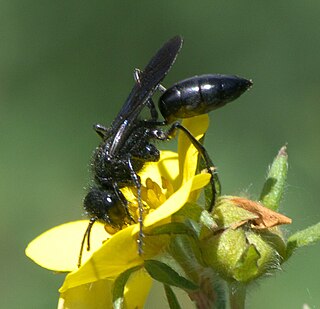 W
WThe Sphecidae are a cosmopolitan family of wasps of the suborder Apocrita that includes sand wasps, mud daubers, and other thread-waisted wasps.
 W
WThe Stephanidae, sometimes called crown wasps, are a family of parasitoid wasps placed in the superfamily Stephanoidea, which has at least 345 living species in 11 genera. The family is considered cosmopolitan in distribution, with the highest species concentrations in subtropical and moderate climate zones. Stephanidae also contain four extinct genera described from both compression fossils and inclusions in amber.
 W
WThe Tetracampidae are a small family of parasitic wasps in the superfamily Chalcidoidea. They are parasitoids of phytophagous insects, primarily flies. The 44 species in 15 genera are almost entirely absent from the New World.
 W
WThe Thynnidae are a family of large, solitary wasps whose larvae are almost universally parasitoids of various beetle larvae, especially those in the superfamily Scarabaeoidea. Until recently, the constituents of this family were classified in the family Tiphiidae, but multiple studies have independently confirmed that thynnids are a separate lineage.
 W
WThe Tiphiidae are a family of large, solitary wasps whose larvae are parasitoids of various beetle larvae, especially those in the superfamily Scarabaeoidea. Until recently, this family contained several additional subfamilies, but multiple studies have independently confirmed that these comprise a separate lineage, and are now classified in the family Thynnidae.
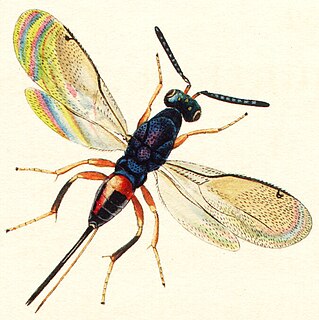 W
WTorymidae is a family of wasps in the superfamily Chalcidoidea. Most species in this family are small with attractive metallic coloration, and females generally have long ovipositors. Many are parasitoids on gall-forming insects, and some are phytophagous (plant-eating) species, sometimes using the galls formed by other insects. Over 960 species in about 70 genera are found worldwide. They are best recognized in that they are one of the few groups of Chalcidoidea in which the cerci are visible.
 W
WThe Trichogrammatidae are a family of tiny wasps in the Chalcidoidea that include some of the smallest of all insects, with most species having adults less than 1 mm in length, with species of Megaphragma having an adult body length less than 300 μm. The over 840 species are placed in about 80 genera; their distribution is worldwide. Trichogrammatids parasitize the eggs of many different orders of insects. As such, they are among the more important biological control agents known, attacking many pest insects.
 W
WTrigonalidae is one of the more unusual families of hymenopteran insects, of indeterminate affinity within the suborder Apocrita, and presently placed in a unique superfamily, Trigonaloidea, and the only extant taxon in the superfamily. The other taxa is an extinct family named Maimetshidae though it is sometimes included in Megalyridae making Trigonalidae the only member in Trigonaloidea. Trigonalidae are divided into 2 subfamilies; Orthogonalinae and Trigonalinae. These wasps are extremely rare, but surprisingly diverse, with over 90 species in over 30 genera and 7 subfamilies, and are known from all parts of the world. It is possibly the sister group to all Aculeata.
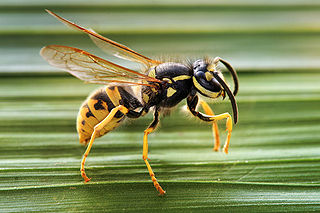 W
WThe Vespidae are a large, diverse, cosmopolitan family of wasps, including nearly all the known eusocial wasps and many solitary wasps. Each social wasp colony includes a queen and a number of female workers with varying degrees of sterility relative to the queen. In temperate social species, colonies usually last only one year, dying at the onset of winter. New queens and males (drones) are produced towards the end of the summer, and after mating, the queens hibernate over winter in cracks or other sheltered locations. The nests of most species are constructed out of mud, but polistines and vespines use plant fibers, chewed to form a sort of paper. Many species are pollen vectors contributing to the pollination of several plants, being potential or even effective pollinators, while others are notable predators of pest insect species.